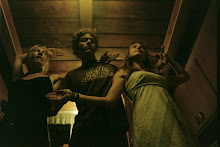
Since the Casual Luddite always has to stay up to date with the modern vogue, I have developed an interest in agriculture, specifically, the “sustainable” alternatives to the dominate forms of industrial agriculture. Of course, us followers of Ludd have a natural aversion to mechanized implements of cultivation. However, since we are somewhat lax in our rejection of the fruits of this system, it is difficult to dismiss it out of hand. After all, even the hardliner Luddite can have some appreciation for the benefits of modern medicine and the convenience of the internet. Can these products exist without the purported abundance of industrial agriculture? Is “sustainable” agriculture so labor-intensive that it would dramatically impact our lifestyle? Do white people look funny in big hats? By interning ourselves at an organic farm, my girlfriend and I hoped to find the answers to these questions and many more.
Green Cedar Farms isn’t much of what you or I would label a “farm.” Positioned on the commanding heights above Oroville in the foothill community of Berry Creek, Green Cedar offers glimpses of the Central Valley, where agricultural operations are hundreds of acres in size. In contrast to these gargantuan flat land farms, Green Cedar is nestled in a complex geography on a foothill ridge. This terrain comes as a relief for a linearly-disabled person such as myself, the curves and turns of the land making straight lines into a futile Cartesian wet dream. Most of the 15 acres here are orchard. Although apples (in many different varieties) predominate, pears and peaches are also to be found along with a scattering of plum, cherry, fig, and other fruit trees.
Our first week saw a good bit of hard labor. Although the orchard is the focal point of Green Cedar, Frank Mazarino and Sally Shea (the operators of Green Cedar and our gracious hosts) also maintain a large garden for their private use. Prepping the beds involved a fair deal of brush clearing (using a small hand-scythe called a coma), adding soil amendments (a mix of gypsum, azomite, kelp, and fertilizer pellets), then turning the soil with shovels.
Outside of the garden we hung pheromone lures to distract the coddling moth, a common pest of fruit trees. By turning the orchard into a sex-crazed moth dance party, we hope that they will not send their worms burrowing into the apples. It appears that this tactic is working, as casualties have been light among the crop, although the unseasonably cool weather we have been getting can only help our efforts to disrupt the moth breeding cycle.
The orchard at Green Cedar is strongly influenced by the no-till ideals from the “do-nothing” school of Masanobu Fukuoka, a Japanese luminary in sustainable agriculture. No-till farming allows the abundant growth of what other farmers would consider “weeds” among the trees, waiting for them to seed, and then chopping them down with mowers. Green mulch such as this augmented by material from the garden builds nutrients in the soil and improves soil structure.
Another task has been thinning pear and apple trees that have been over profligate in their fruit production. Thinning helps prevent branches from breaking under the weight of fruit, as well as assuring that the fruit will be sufficiently sweet for the consumer’s palette. Frank and Sally both pursue a high ideal of “flavor” in their products, not only in culturing sweetness, but also making sure that their diverse array of apples represent a wide spectrum of other flavors, from tart to fruity. Although I consider myself to be a relatively healthful eater, I cannot pretend to be as cultured a connoisseur when it comes to fruit. I’ve been plucking both Gravensteins and Pink Pearls (two early season apples) and enjoying their tart, pre-ripe flavor.
Unfortunately, while Frank and Sally are faithful to their ethics and attempt to channel nature in the most productive way possible, conflicts are inevitable. The early part of our stay here involved a prolonged struggle with the birds, who had their sights on the farm’s several cherry trees. Even netting and distraction trees (alternatives to cherries, such as mulberries and native cherries, planted specifically for the birds) could not dissuade the determined flock of tanagers, stellar jays, grosbeaks, and robins from taking a sizable portion of the crop. However, now that we are past the cherry season, Frank is already starting to sing the praises of his avian friends, claiming that they are helping suppress the coddling moth by eating the worms before they penetrate to the apple cores.
I’ll have more to report in a few days; even in this long of a post many things have gone unreported. I swear that the happenings on the farm have not been half as boring as I have made them seem. Well, there are some slow times weed whacking…but there is plenty of bird fighting, good stories, good food, and yes, white people in big hats to entertain anyone. But more on that next time.







